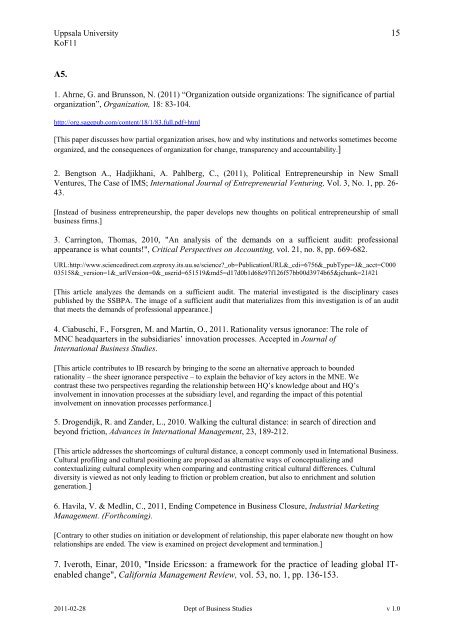Evaluation document, KoF11 Part A: Strategic aspects on research ...
Evaluation document, KoF11 Part A: Strategic aspects on research ... Evaluation document, KoF11 Part A: Strategic aspects on research ...
Uppsala University 15
Uppsala University 16
- Page 3 and 4: Uppsala University 3KoF11</
- Page 5: Uppsala University 5KoF11</
- Page 10 and 11: Uppsala University 10KoF11<
- Page 12 and 13: Uppsala University 1KoF11</
- Page 14 and 15: Uppsala University 3KoF11</
- Page 16 and 17: Uppsala University 5KoF11</
- Page 18 and 19: Uppsala University 7KoF11</
- Page 20 and 21: Uppsala University 9KoF11</
- Page 22 and 23: Uppsala University 11KoF11<
- Page 24 and 25: Uppsala University 13KoF11<
- Page 26 and 27: Uppsala University 15KoF11<
- Page 28 and 29: Uppsala University 1KoF11</
- Page 30 and 31: Uppsala University 3KoF11</
- Page 32 and 33: Uppsala University 5KoF11</
- Page 34 and 35: Uppsala University 7KoF11</
- Page 36 and 37: Uppsala University 9KoF11</
- Page 38 and 39: Uppsala University 11KoF11<
- Page 40 and 41: Uppsala University 13KoF11<
- Page 44 and 45: Uppsala University 17KoF11<
- Page 46 and 47: Uppsala University 19KoF11<
- Page 48 and 49: Uppsala University 21KoF11<
- Page 50 and 51: Uppsala University 1KoF11</
- Page 52 and 53: Uppsala University 3KoF11</
- Page 54 and 55: Uppsala University 5KoF11</
- Page 56 and 57: Uppsala University 7KoF11</
- Page 58 and 59: Uppsala University 9KoF11</
- Page 60 and 61: Uppsala University 11KoF11<
- Page 62 and 63: Uppsala University 13KoF11<
- Page 64 and 65: Uppsala University 2KoF11</
- Page 66 and 67: Uppsala University 4KoF11</
- Page 68 and 69: Uppsala University 6KoF11</
- Page 70 and 71: Uppsala University 8KoF11</
- Page 72 and 73: Uppsala University 10KoF11<
- Page 74 and 75: Uppsala University 12KoF11<
- Page 76 and 77: Uppsala University 14KoF11<
- Page 78 and 79: Uppsala University 16KoF11<
- Page 80 and 81: Uppsala University 18KoF11<
- Page 82 and 83: Uppsala University 1KoF11</
- Page 84 and 85: Uppsala University 3KoF11</
- Page 86 and 87: Uppsala University 5KoF11</
- Page 88 and 89: Uppsala University 7KoF11</
- Page 90 and 91: Uppsala University 9KoF11</
Uppsala University 15<str<strong>on</strong>g>KoF11</str<strong>on</strong>g>A5.1. Ahrne, G. and Brunss<strong>on</strong>, N. (2011) “Organizati<strong>on</strong> outside organizati<strong>on</strong>s: The significance of partialorganizati<strong>on</strong>”, Organizati<strong>on</strong>, 18: 83-104.http://org.sagepub.com/c<strong>on</strong>tent/18/1/83.full.pdf+html[This paper discusses how partial organizati<strong>on</strong> arises, how and why instituti<strong>on</strong>s and networks sometimes becomeorganized, and the c<strong>on</strong>sequences of organizati<strong>on</strong> for change, transparency and accountability.]2. Bengts<strong>on</strong> A., Hadjikhani, A. Pahlberg, C., (2011), Political Entrepreneurship in New SmallVentures, The Case of IMS; Internati<strong>on</strong>al Journal of Entrepreneurial Venturing, Vol. 3, No. 1, pp. 26-43.[Instead of business entrepreneurship, the paper develops new thoughts <strong>on</strong> political entrepreneurship of smallbusiness firms.]3. Carringt<strong>on</strong>, Thomas, 2010, "An analysis of the demands <strong>on</strong> a sufficient audit: professi<strong>on</strong>alappearance is what counts!", Critical Perspectives <strong>on</strong> Accounting, vol. 21, no. 8, pp. 669-682.URL:http://www.sciencedirect.com.ezproxy.its.uu.se/science?_ob=Publicati<strong>on</strong>URL&_cdi=6756&_pubType=J&_acct=C000035158&_versi<strong>on</strong>=1&_urlVersi<strong>on</strong>=0&_userid=651519&md5=d17d0b1d68e97f126f57bb00d3974b65&jchunk=21#21[This article analyzes the demands <strong>on</strong> a sufficient audit. The material investigated is the disciplinary casespublished by the SSBPA. The image of a sufficient audit that materializes from this investigati<strong>on</strong> is of an auditthat meets the demands of professi<strong>on</strong>al appearance.]4. Ciabuschi, F., Forsgren, M. and Martín, O., 2011. Rati<strong>on</strong>ality versus ignorance: The role ofMNC headquarters in the subsidiaries’ innovati<strong>on</strong> processes. Accepted in Journal ofInternati<strong>on</strong>al Business Studies.[This article c<strong>on</strong>tributes to IB <strong>research</strong> by bringing to the scene an alternative approach to boundedrati<strong>on</strong>ality – the sheer ignorance perspective – to explain the behavior of key actors in the MNE. Wec<strong>on</strong>trast these two perspectives regarding the relati<strong>on</strong>ship between HQ’s knowledge about and HQ’sinvolvement in innovati<strong>on</strong> processes at the subsidiary level, and regarding the impact of this potentialinvolvement <strong>on</strong> innovati<strong>on</strong> processes performance.]5. Drogendijk, R. and Zander, L., 2010. Walking the cultural distance: in search of directi<strong>on</strong> andbey<strong>on</strong>d fricti<strong>on</strong>, Advances in Internati<strong>on</strong>al Management, 23, 189-212.[This article addresses the shortcomings of cultural distance, a c<strong>on</strong>cept comm<strong>on</strong>ly used in Internati<strong>on</strong>al Business.Cultural profiling and cultural positi<strong>on</strong>ing are proposed as alternative ways of c<strong>on</strong>ceptualizing andc<strong>on</strong>textualizing cultural complexity when comparing and c<strong>on</strong>trasting critical cultural differences. Culturaldiversity is viewed as not <strong>on</strong>ly leading to fricti<strong>on</strong> or problem creati<strong>on</strong>, but also to enrichment and soluti<strong>on</strong>generati<strong>on</strong>.]6. Havila, V. & Medlin, C., 2011, Ending Competence in Business Closure, Industrial MarketingManagement. (Forthcoming).[C<strong>on</strong>trary to other studies <strong>on</strong> initiati<strong>on</strong> or development of relati<strong>on</strong>ship, this paper elaborate new thought <strong>on</strong> howrelati<strong>on</strong>ships are ended. The view is examined <strong>on</strong> project development and terminati<strong>on</strong>.]7. Iveroth, Einar, 2010, "Inside Ericss<strong>on</strong>: a framework for the practice of leading global ITenabledchange", California Management Review, vol. 53, no. 1, pp. 136-153.2011-02-28 Dept of Business Studies v 1.0



